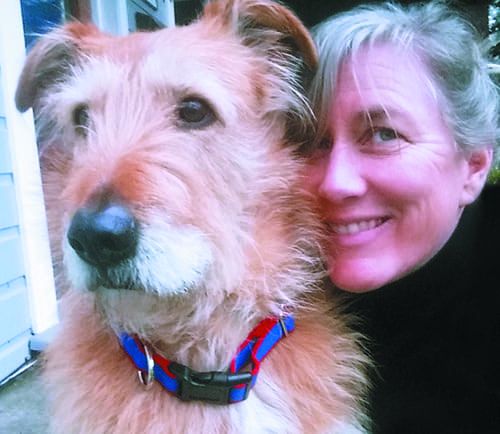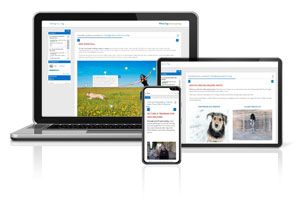The newest online course from Whole Dog Journal
Social Anxiety and Your Dog
Is your dog a social outcast?
Is he anxious, snarly, or growly upon meeting other dogs (or people)? Do those tail-tucking, skittish retreats make you a nervous wreck? Give your dog a new lease on (social) life! Enroll in our dynamic new online learning experience!
Here’s a quiz only you can answer: How many of the following adjectives describe your dog when he encounters other dogs or humans?
✅ Shy
✅ Shaky
✅ Scared
✅ Skittish
✅ Suspicious
✅ Panicky
✅ Growly
✅ “Barky”
✅ Angry
✅ Aggressive
✅ Threatening
Checking one or more boxes means your best canine friend is struggling with social anxiety. That may not be news to you. Perhaps you’ve already found out the hard way…
➔ …that having a scared, timid dog makes playdates near-impossible.
➔ …that having a skittish dog turns a simple leash walk into a complicated chore.
➔ …that having a panicky dog makes it a challenge to invite guests to your home.
➔ …that if a dog is triggered into aggressive behavior by the mere sight of another dog, things can turn dangerous — and fast.
Don’t despair. Don’t just “let it be.” Don’t wait for your dog to become well-adapted on his own. Instead, enroll in Whole Dog Journal’s online course Social Anxiety and Your Dog!
SO WHAT IS “SOCIAL ANXIETY AND YOUR DOG”?
Our online course is an easy-to-follow, information-packed learning experience. Within our common-sense lessons, you’ll discover the reasons behind a dog’s social anxiety… along with accessible solutions.
● Learn the telltale signs of a socially anxious dog.
● Gain an understanding of how anxiety differs from phobias and fears — and why it matters.
● Get a grasp on CC&D — counter-conditioning and desensitization — and why it’s so effective in addressing social anxiety.
And that’s not all! In our course, you will:
● Find out how to reduce your dog’s anxiety in settings that trigger her fears.
● Take the next steps in socializing your dog, whether he’s a puppy or a senior (or in between)!
● Learn why it’s okay to comfort a dog who can’t get past her fearful behavior.
Our enrollment process is quick and easy. Sign up and then start the process of easing your dog’s social anxiety. Help him adapt more easily!
HELP ROVER RELAX!
“GRRRR… WOOF-WOOF!! WOOF-WOOF-WOOF!!!” You know that progression of sounds. You may have heard it when your dog encountered a tall, imposing human who set him on his guard. If he inexplicably went bark-crazy, it was likely based in fear.
Remember that fear is a valuable adaptive emotion — necessary for survival. Fear is totally appropriate in a wide range of situations: when evading a bear during a hike, for example, or rushing out of the path of an oncoming car.
Yet fear can become a problem. Fear-related aggression is a significant risk to a dog’s long and happy life. A constant emotional state of fear makes for a poor quality of life for a dog — and for humans who become stressed by their behavior.
As our experts explain, “A fearful dog’s first choice is usually to escape, but he may bite defensively — which could end up with euthanasia.”
The good news? Dogs can learn to overcome their fears and their anxieties! Our course shows how.
Sign up and get started right away. Once you enroll, the course is yours to keep, so you can review the material as often as you want.
WHAT YOU’LL LEARN
• Socially anxious dogs may exhibit reactive behavior. What is reactive behavior? A dog becomes overly aroused when confronted with otherwise common stimuli. They may lunge, bark, and growl and become difficult to control. Any reactive dog can be pushed into aggression, which is why a reactive dog needs to be taken seriously. Learn more in our course!
• Socially anxious dogs may be “untouchable.” They may totally resist human contact. And considering how often we pick up, pet, attach leashes to collars, and touch our dogs so often, having him slink away from physical contact is a problem. BUT… it’s one you can fix, per the advice described in our course.
• Socially anxious dogs may benefit from medications. Learn in a special section of our course when (and which) anti-anxiety medications are effective and safe — and may be an option for your dog.
TRY OUR COURSE RISK-FREE — AND OWN IT!
How do our online courses work? If you haven’t taken a Whole Dog Journal online course, you’ll find it simple:
➔ Log in with your own username and password — and start learning whenever you want!
➔ Go through the course in short increments or in one sitting.
➔ Log in any time of day (or night!).
➔ Fit your learning into your own schedule, viewing and reviewing the material often as you want!
Best news: You OWN the course once you’ve enrolled. You can view whenever and wherever you want, on any device.
Give your dog a new lease on (social) life! Enroll now in Social Anxiety and Your Dog and enjoy our 100% satisfaction guarantee!
YOUR DOG’S SOCIAL STRUGGLES CAN END NOW!
How do you rescue your dog from anxieties that make her skittish, shy, panicky, or aggressive in social settings? Find out in our interactive course.
Topics covered include:
• Fear, Anxiety, and Phobia: What’s the Difference?
• Telltale Stress Signals in Dogs
• Do You Have a Panting Dog? Here’s Why!
• How to Socialize a Dog
• What Causes Aggressive Behavior in Dogs?
• How (and Why) to Comfort an Anxious Dog
• Training Your Dog to Behave Around Guests
• Test Your Knowledge: Course Quiz
Learn in the comfort of your home — with your dog by your side!
ASK THE EDITOR
Q: My dog cowers in fear behind my legs when people we meet during walks try to pet her. Should I push her forward so she can learn they’re not a threat?
A: Actually, no. Protect your dog from unwanted advances by well-meaning strangers who want to pet her. Don’t let people stroke or harass her until she’s socialized enough to tolerate petting.
Q: I’ve read about counter-conditioning and desensitization as strategies to socialize a dog. Do they work?
A: Yes! Counter-conditioning and desensitization (CC&D) involves changing your dog’s association with a scary stimulus — new people or dogs, for example — from negative to positive. The easiest way to give most dogs a positive association? High-value (read: tasty) treats. In our course, you’ll learn different ways of CC&D training.
Enroll in Social Anxiety and Your Dog and gain unlimited access for just $19.95. That’s a $10 savings! Watch the course from any device as often as you want.
 The host of Social Anxiety and Your Dog is Whole Dog Journal founding editor and dog mom, Nancy Kerns. For more than 25 years, she has been writing about the effectiveness and benefits of force-free, dog-friendly training, as well as reporting on up-to-date research on canine behavior and health. Nancy shares her life with her Pit/Lab-mix Woody who serves as “Fun Uncle” for the many puppies she fosters for a local shelter.
The host of Social Anxiety and Your Dog is Whole Dog Journal founding editor and dog mom, Nancy Kerns. For more than 25 years, she has been writing about the effectiveness and benefits of force-free, dog-friendly training, as well as reporting on up-to-date research on canine behavior and health. Nancy shares her life with her Pit/Lab-mix Woody who serves as “Fun Uncle” for the many puppies she fosters for a local shelter.

